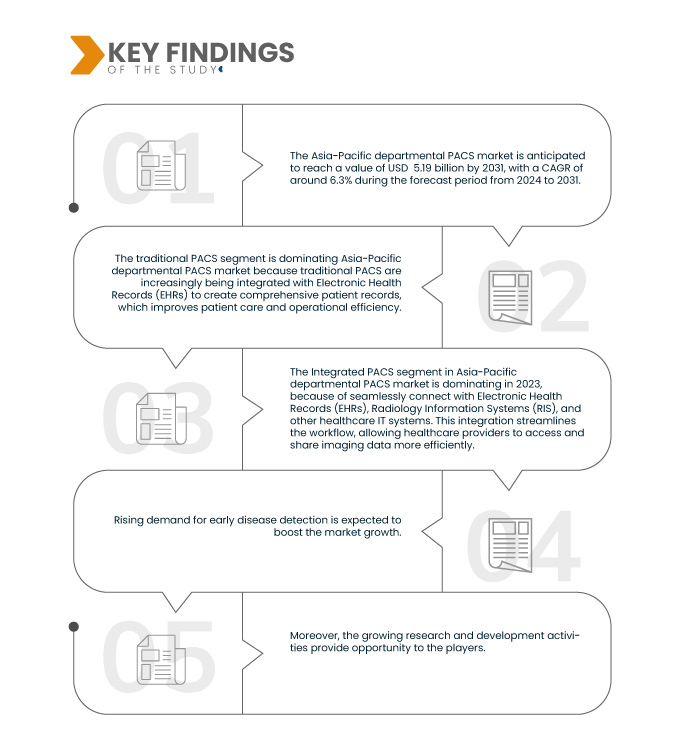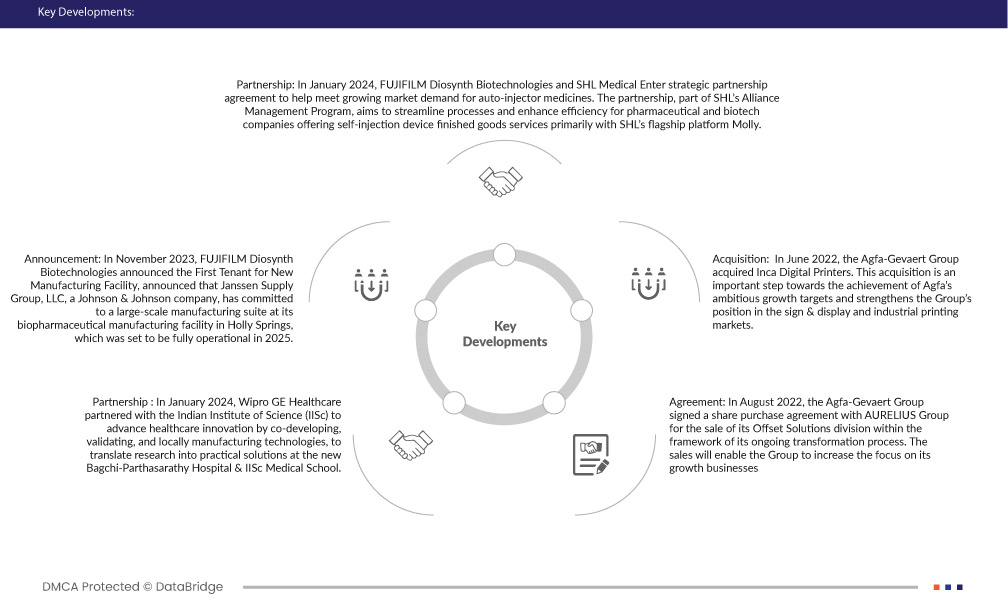The rising demand for early disease detection significantly drives the APAC Departmental PACS (Picture Archiving and Communication System) market, primarily because PACS technology enhances the efficiency and accuracy of diagnostic processes. Early disease detection often relies on advanced imaging techniques, which generate vast amounts of data needing efficient storage, retrieval, and analysis. PACS systems provide a digital solution to manage this data, allowing for quick and easy access to medical images and associated information. This capability is crucial for early disease detection, where timely and precise diagnosis can drastically improve patient outcomes. Also, the growing awareness and adoption of preventive healthcare measures in the APAC region have led to increased investments in healthcare infrastructure, including imaging technologies and PACS systems. Governments and healthcare organizations are prioritizing early detection programs to reduce the long-term burden of chronic diseases, further boosting the demand for robust PACS solutions. The integration of artificial intelligence (AI) and machine learning (ML) with PACS is also accelerating this trend, as these technologies enhance image analysis, improve diagnostic accuracy, and facilitate the early identification of diseases. Consequently, the escalating emphasis on early disease detection is propelling the expansion of the APAC Departmental PACS market as healthcare providers strive to adopt innovative solutions to meet the growing demand for efficient and effective diagnostic tools.
For instance,
- In November 2023, according to an article published in the journal Radiology Oncology Systems, PACS explored diagnostic imaging equipment’s pivotal role in identifying diseases at their earliest stages. Diagnostic imaging techniques such as X-rays, CT scans, PET scans, MRIs, and ultrasounds remained the frontline defenders against hidden health threats. They enabled healthcare professionals to peer inside the body, unveiling anomalies, often before symptoms surface. In a recent study, it was revealed that early diagnosis through diagnostic imaging led to an approximately 20% increase in the effectiveness of cancer treatment options for lung cancer (American Association for Cancer Research). PACS plays a vital role in the prevention and treatment of disease
- In November 2022, according to an article published in GE HealthCare, when patients were disadvantaged from achieving their full health potential, health inequities were reflected in differences in length of life, quality of life, rates of disease, disability, and death, severity of disease, and access to treatment. The inability to access important components in the care path, such as medical imaging, could have a dramatic effect on health outcomes. Advanced medical imaging systems like PACS needed to focus on the early diagnosis of non-communicable or chronic diseases, such as cardiovascular diseases, chronic respiratory diseases, and diabetes. Early diagnosis is necessary to avoid further illness and wrong treatment and expenditure
- In August 2020, according to the report published by EIT Health, new healthcare technologies like PACS were constantly developed at a rapid pace and allowed the detection and diagnosis of diseases at an earlier stage. This trend was also known as early diagnostics, and expected to lead to significant change within healthcare systems as the way that diseases are found and treated are set to be reshaped. It has the potential to improve the quality of care, lower costs and provide treatment at an earlier time. Reducing downstream treatment costs for payers and society, lowering hospitalization rates and pressure on hospitals and clinicians, prescribing the right treatment for a patient, avoiding unnecessary intervention
The growing focus on early disease detection is a significant driver of the APAC Departmental PACS market because PACS technology streamlines the management of vast imaging data, which is crucial for timely and accurate diagnoses. As preventive healthcare gains traction in the region, investments in PACS systems increase, supported by the integration of AI and ML for enhanced diagnostic precision. This trend underscores the critical role of PACS in meeting the rising demand for effective diagnostic tools, thereby fostering market growth.
Access Full Report @ https://www.databridgemarketresearch.com/reports/asia-pacific-departmental-pacs-market
Data Bridge Market Research analyzes that the Asia-Pacific Departmental PACS Market is expected to reach USD 5.19 billion by 2031 from USD 3.19 billion in 2023, growing with a CAGR of 6.3% in the forecast period of 2024 to 2031.
Key Findings of the Study
Report Scope and Market Segmentation
|
Report Metric
|
Details
|
|
Forecast Period
|
2024 to 2031
|
|
Base Year
|
2023
|
|
Historic Years
|
2022 (Customizable 2016-2021)
|
|
Quantitative Units
|
Revenue in USD Billion
|
|
Segments Covered
|
Product Type (Traditional PACS, Specialty PACS), Component (Software, Services, Hardware), Application (Magnetic Resonance Imaging (MRI), Computed Tomography (CT), Digital Radiography, Ultrasound, Nuclear Imaging, C-Arms, Others), Integration Level (Integrated PACS, Standalone PACS), End User (Hospitals, Radiology Chains/Centers, Ambulatory Surgical Centers, Others), By Distribution Channel (Direct Tenders, Third Party Administrators, and Others)
|
|
Countries Covered
|
Japan, China, India, South Korea, Australia, Singapore, Malaysia, Thailand, Indonesia, Philippines, rest of Asia-Pacific
|
|
Market Players Covered
|
FUJIFILM Corporation (Japan), GE Healthcare (U.S.), Koninklijke Philips N.V. (Europe), Agfa-Gevaert Group. (Belgium), Hyland Software, Inc. (U.S.), Lexmark International Inc. (U.S.), Mach 7 Technologies Limited (U.S.), Novarad Enterprise Healthcare Solutions (U.S.), Reyence (Korea), Siemens (Siemens Healthcare Private Limited) (Europe), Sectra AB (Europe), Softneta (Europe), SinoVision (China), TeleRAD Reporting Services Private Limited (India), and Voyager Imaging (Australia) among others
|
|
Data Points Covered in the Report
|
In addition to the insights on market scenarios such as market value, growth rate, segmentation, geographical coverage, and major players, the market reports curated by the Data Bridge Market Research also include in-depth expert analysis, patient epidemiology, pipeline analysis, and regulatory framework
|
Segment Analysis
Asia-Pacific departmental PACS market is segmented into six notable segments based on Product Type, Component, Application, Integration Level, End User, and Distribution Channel.
- On the basis of product type, the market is segmented into traditional PACS, and speciality PACS
In 2024, the traditional PACS segment is expected to dominate the Asia-Pacific departmental PACS market
In 2024, the traditional PACS segment is expected to dominate the market with a market share of 53.70% due to growing healthcare needs.
- On the basis of component, the market is segmented into software, services, and hardware
In 2024, the software segment is expected to dominate the Asia-Pacific departmental PACS market.
In 2024, the Software segment is expected to dominate the market with a market share of 46.54% due to the increasing disorders.
- On the basis of application, the market is segmented into magnetic resonance imaging (MRI), computed tomography (CT), digital radiography, ultrasound, nuclear imaging, c-arms, others. In 2024, magnetic resonance imaging (MRI) segment is expected to dominate the market with a market share of 30.81%
- On the basis of integration level, the market is segmented into Integrated PACS, Standalone PACS. In 2024, integrated PACS segment is expected to dominate the market with a market share of 53.70%
- On the basis of end user, the market is segmented into hospitals, radiology chains/centres, ambulatory surgical centres, and others. In 2024, hospital segment is expected to dominate the market with a market share of 43.65%
- On the basis of distribution channel, the market is segmented into direct tenders, third party administrators, and others. In 2024, hospital segment is expected to dominate the market with a market share of 45.89%
Major Players
Data Bridge Market Research analyzes FUJIFILM Corporation (Japan), GE Healthcare (U.S.), Koninklijke Philips N.V. (Europe), Agfa-Gevaert Group. (Belgium), Hyland Software, Inc. (U.S.), Lexmark International Inc. (U.S.), Mach 7 Technologies Limited (U.S.), Novarad Enterprise Healthcare Solutions (U.S.), Reyence (Korea), Siemens (Siemens Healthcare Private Limited) (Europe), Sectra AB (Europe), Softneta (Europe), SinoVision (China), TeleRAD Reporting Services Private Limited (India), and Voyager Imaging (Australia) among others are the major companies operating in the Asia-Pacific Departmental PACS market.
Market Developments
- In January 2024, FUJIFILM Diosynth Biotechnologies and SHL Medical entered strategic partnership agreement to help meet growing market demand for auto injector medicines. The partnership, part of SHL’s Alliance Management Program, aimed to streamline processes and enhance efficiency for pharmaceutical and biotech companies offering self-injection device finished goods services primarily with SHL’s flagship platform Molly
- In January 2024, Wipro GE Healthcare partnered with the Indian Institute of Science (IISc) to advance healthcare innovation by co-developing, validating, and locally manufacturing technologies, to translate research into practical solutions at the new Bagchi-Parthasarathy Hospital & IISc Medical School. This collaboration enhanced the company’s ability to drive impactful medical technology advancements and expand its market presence in India
Regional Analysis
Geographically, the countries covered in the Asia-Pacific Departmental PACS market report Japan, China, India, South Korea, Australia, Singapore, Malaysia, Thailand, Indonesia, Philippines, and rest of Asia-Pacific.
As per Data Bridge Market Research analysis:
For more detailed information about the Asia-Pacific Departmental PACS market report, click here – https://www.databridgemarketresearch.com/reports/asia-pacific-departmental-pacs-market













